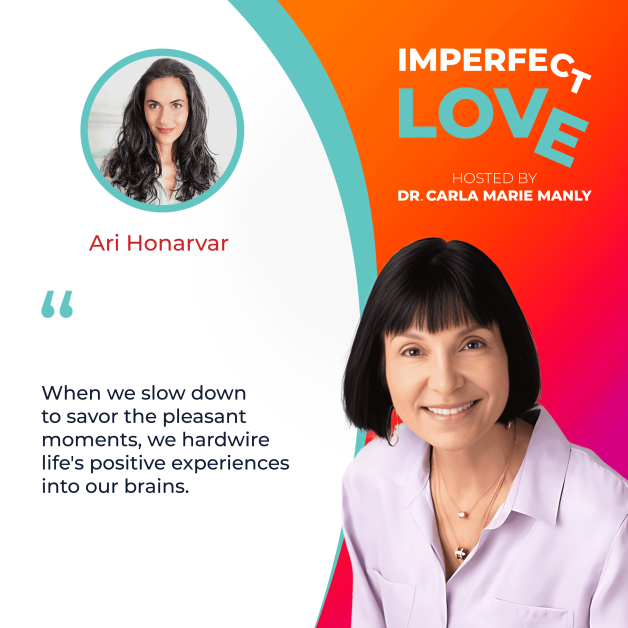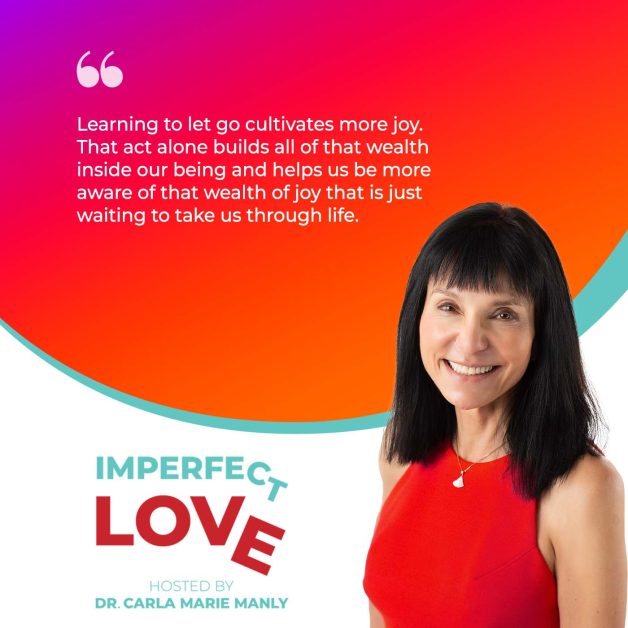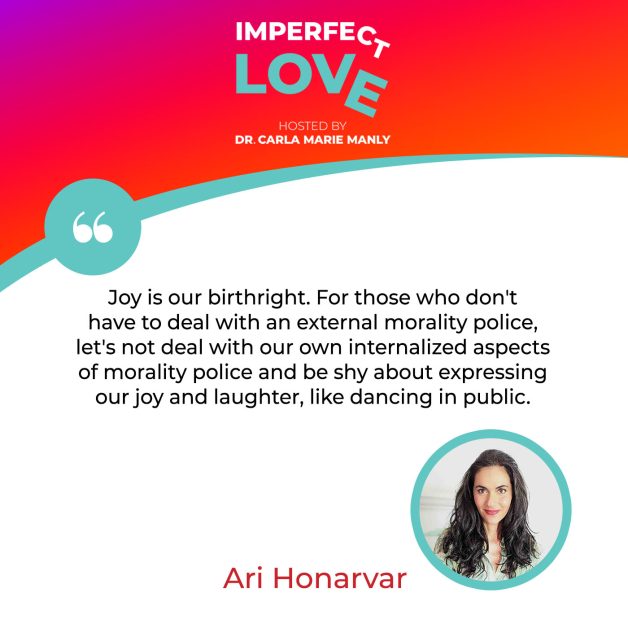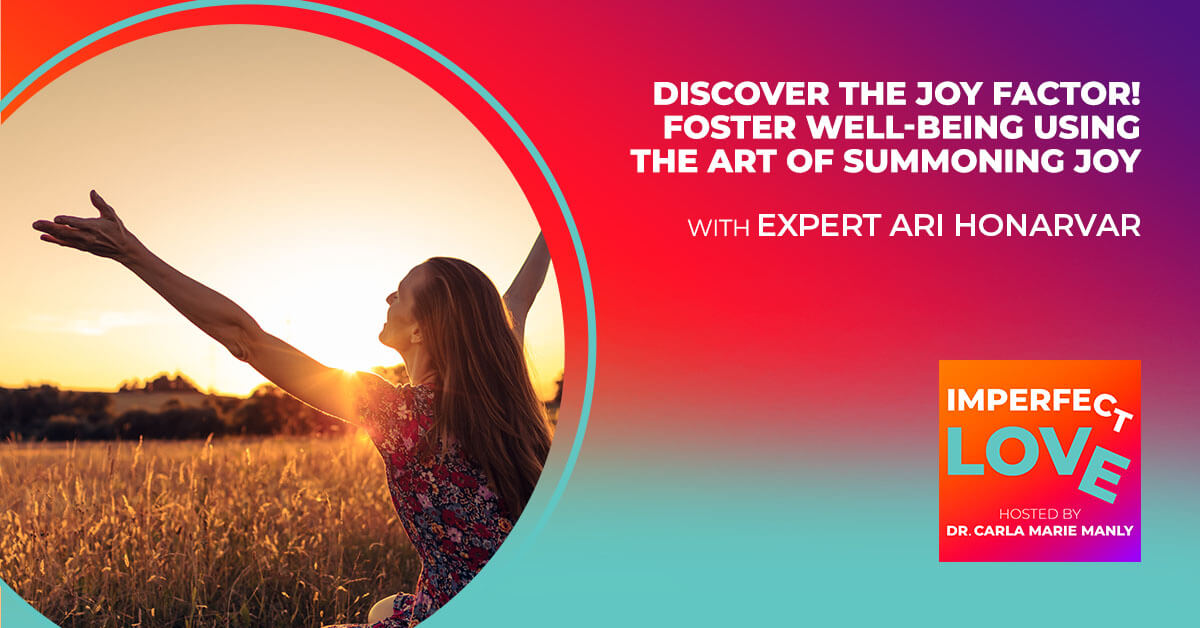Discover the Joy Factor! Boost your mental health and improve your resilience through the practice of summoning joy. The negativity bias—the natural, protective tendency for a bad experience to take more of our attention than good or neutral experiences—prevents us from learning from and embracing our positive experiences. We can learn to create a nurturing, safe internal sanctuary by learning to notice and savor the joyful moments life brings. Discover the art of accessing creative energy to foster mindfulness and delight. Join Dr. Carla and Ari Honarvar, an award-winning author, TEDx speaker, and joy expert, for a powerfully uplifting journey into the healing realm of inner joy.
Books by Dr. Carla Manly:
Date Smart: Transform Your Relationships and Love Fearlessly
Joy From Fear: Create the Life of Your Dreams by Making Fear Your Friend
Books by Ari Honarvar:
Connect with Dr. Carla Manly:
Website: https://www.drcarlamanly.com
Instagram: https://www.instagram.com/drcarlamanly/
Twitter: https://www.twitter.com/drcarlamanly/
Facebook: https://www.facebook.com/drcarlamanly
LinkedIn: https://www.linkedin.com/in/carla-marie-manly-8682362b/
YouTube: https://www.youtube.com/@dr.carlamariemanly8543
TikTok: https://www.tiktok.com/@dr_carla_manly
Connect with Ari Honarvar:
Website: https://rumiwithaview.com/
—
Watch the episode here
Listen to the podcast here
DISCOVER THE JOY FACTOR! Foster Well-Being Using the Art of Summoning Joy with Expert Ari Honarvar
Boost Your Mental Health and Resiliency with The Power of Mindfulness and Creativity!
The joy factor, you can boost your mental health with the practice of summoning joy. The negativity bias, our protective tendency for a bad experience to take more of our attention than a good or neutral experience prevents us from learning and embracing our positive experiences. We can learn to create a nurturing, safe internal sanctuary by focusing on and savoring the joyful moments life brings. In this way, even life’s biggest challenges can be handled with more joy and resiliency.
In this episode, we’ll focus on this real-life question. “I’ve suffered a lot in my life, my mother died when I was five, and my dad died a few years later. It feels like I’ve had nothing but loss ever since. I was diagnosed with breast cancer and my partner is not very supportive. I try to practice gratitude and want joy, but I feel like I’m going through the motions. I feel lost, alone, and depressed. How can I do more than just survive?” That question is the focus of this episode.

In this episode, I am thrilled and blessed to introduce our very special guest, Ari Honarvar, who will be sharing her experiences on joy and cultivating and repairing all relationships with the self, with others in the world, and with the divine. Ari, it is such a delight to have you. Thank you for being with us.
It’s such a pleasure to be here, savoring your beautiful presence and having this moment for us to be together.
Ari, thank you. You bring so much to the world. Your energy and your way of being is radiant. That’s why I thought you would be an especially good fit for this question because you have known so many challenges in life and sorrows, yet you manage to cultivate joy. Before we dive into the question, would you share with our readers a little bit about what makes you, you?
My story begins in Iran when I was a normal six-year-old when women’s rights were cut in half. The Islamists took over the government and a war on women began where kids or girls like me couldn’t go outside without wearing a cover on their bodies and hair. We couldn’t ride a bicycle, we couldn’t sing, and we couldn’t dance. All of that was happening. Neighboring Iraq, Saddam Hussein, was in charge and took advantage of this internal turmoil and started a war on top of everything that was happening with Iran that lasted eight years and destroyed countless lives. The loss of our rights was a source of grief and loss of ability to express ourselves.
The war on joy was a source of grief. We had literal sources of grief like people around us disappearing, imprisoned, and executed by the regime, and with the bombings and the war that destroyed so many lives, almost a million people. We were used to going to daily funerals. It was a situation loss. I feel so much for the person who asked the question who’s having such a hard life having all these losses. I can also have a glimpse of what that could be like based on my own experience. All experiences are different.
Discover the immense power of joy! Boost your mental health and resilience by embracing joy, mindfulness, and creativity! Join Dr. Carla and Ari Honarvar, acclaimed author, TedX speaker, and joy expert for a powerfully uplifting dive into the art… Share on XWhat I noticed as a kid was that when all the adults around me cultivated joy through creativity, the arts, or even telling jokes or singing while they were cooking in the privacy of their own homes, painting, or writing, they fared a lot better than everyone else. It started a lifelong curiosity. Several years ago, researchers came up with this phrase, savoring intervention, where rather than focusing on all the bad things that are happening, we can gently guide our attention to what’s right. That’s a little bit of what I’ve been involved with, the savoring practice. I dance with refugees who also go through so much loss and trauma in their lives. We savor our dance sessions together, being together in the community, enjoying a meal, and using all of our five senses together too.
Thank you for that beautiful and somewhat in-depth introduction into what makes you, you. Another few pieces of you, because we’ve talked before, is you have created these beautiful Oracle Cards and you’re also a bestselling author of Rumi With A View. Before we wind our way to the question, could you tell our readers a little bit about your book? I do have to say I have your cards. They’ve been with me for several years, and I love being and sitting with your Oracle Cards. Could you tell us a little bit about both, please?
Thank you so much. For the cards, I wanted to create something to combine the Western Art of Tarot and the Persian Ancient Art of Divination through Rumi’s poetry. Every card has a Rumi verse embedded in it in Farsi, the image cards. There are poem cards that correspond to every image. Everyone has a title like freedom, celebration, work, or treasure. They come packaged with a guided meditation book based on all the stories that were passed down to me, generation after generation, and my own reflections on the verses.
A lot of therapists use them in sessions with their patients, especially young therapists. The images would come out. Yoga teachers or individuals would use them as a meditation prompt in the morning or for the dinner conversation when people want to pull a card and discuss it together. That’s my cards. My book, A Girl Called Rumi, is based on my experiences growing up in post-revolution Iran, where our rights were cut in half and the portal that opened in my imagination as a kid.
One of the ways I savored was it started my practice of savoring was not through the external world because there was so much bad stuff going on, but retreating into the world of imagination. In the book, a nine-year-old and her best friend come across a portal on the ruins of missile attacks. This portal takes them on this mythical journey that God has so much wisdom and mystical knowledge from the 12th and 13th-century mystics and this mythical bird, the Simurgh, which shows up and it’s an elusive bird that is an allegory for enlightenment that shows up in the book.
Want to summon joy? Our natural negativity bias prevents us from embracing our positive experiences, yet we can nurture a safe internal sanctuary by learning to savor life's joyful moments. Join Dr. Carla and expert Ari Honarvar for a powerful… Share on XBoth of them are so exquisite. The cards especially are a lovely way for us to go to the question about how something as simple as beautiful as a card, an oracle card, a thought card, or a gratitude card can evoke how we can sit with that and let go of our worries, our grief, and our troubles if only for a minute and immerse ourselves in a moment of joy. Could you tell us how someone could use something as simple as these beautiful cards or a piece of artwork, a piece of nature, or a photograph to bring about joy? Could you describe that, please?
Also, a song or a smell. Many refugees have lost their homes and their loved ones. Most of the kids have lost their siblings. Most of the parents have lost their children. When we play a song that reminds them of home and the good times they had before all these losses occurred and we’re dancing together, something miraculous happens. They’re able to savor the memories of what was and how beautiful it was. The song takes them back to a beautiful place.
There are multiple channels where we can tap into cultivating joy through savoring. I generally don’t cultivate gratitude. What I do is I try to provide sufficient grounds for gratitude if it wants to arise. I don’t go right after gratitude. What I do is I bring about ways that we can get into the zone and see what arises, whether it’s happiness, contentment, or gratitude through a piece of a card, a drawing, or a beautiful photo.
If we engage our senses, like the texture of the card or the photo in our hand, how does it feel? What do we see in that piece of art? How can our eyes follow and gently go to what’s pleasing, what colors and textures, and then see what it reminds us of? Are there any smells while we’re looking at this? If we’re out in nature, if we see a flower, what is that smell like if we inhale the lung full of the aroma of the flower and see the bees around it, see the shape of the sky and the clouds, and how puffy they are, or how whatever texture they might be? How does our feet feel on the ground?
By bringing ourselves to our five senses, what sounds do we hear? It provides sufficient grounds for savoring and allowing the neural structures to get stronger as we keep doing it throughout the day. When we have a cup of tea, to be with the tea and the texture of the cup, the warmth of the cup, the taste of the first sip, etc., that’s one way that we can keep shifting our focus to what’s right and bring it gently back from trauma.
Give yourself a dose of self-care! Discover the art of accessing healing joy and creative energy to foster mindfulness and delight. Join Dr. Carla and Ari Honarvar, author, TEDx speaker, and joy expert, for a powerfully uplifting journey into the… Share on XI love how you describe that because, not to minimize our reader’s grief and all of the terrible traumas she’s suffered in life, but realizing that one of the gifts we might be able to bring her is the realization that if she’s able to grow in internal resilience in mindfulness, which feels very much to me like that’s what we’re talking here. It is the mindfulness of being in the moment, of savoring the moment, and allowing ourselves to be present for, as you say, as you smell a flower, you notice the bees, you are taking in the scent, and the feeling of the air. We can’t be in the future or the past at that time. We can’t be thinking about all of our losses and we can’t be worried about what chemotherapy or cancer might be bringing us.
Instead, what you’re describing is this art of immersing ourselves, savoring this precious moment, and using the five senses, as you said, your eyes. Even if your eyes are closed, it’s interesting how our eyes still give us information when they’re closed. Our ears, our nose, our fingers, all of our senses, and even our sixth sense to allow ourselves to build internal joy and internal resilience. I can see as you’re talking how that creates gratitude almost as a byproduct because how can we not smell that rose, sniff the lavender, look in awe at that dragonfly or bird, and be grateful? At that moment, we are grateful. We are there. I love that you bring that forward, that peace of savoring, being present, and soaking in this very moment. We just have this moment.
I loved how you said this is not to minimize the loss. It is so important to acknowledge the reality of what’s happening to us. Not to minimize and not to bypass it. What the savoring practice allows is for our capacity to hold that loss to be in the difficulty of reality. Our current situation allows us to have a better capacity, a bigger capacity, and become more spacious in the way that we handle challenges.
Support is particularly important in grief and loss. When we are left with a situation where we don’t have a supportive situation for us, then we can tap into the support of nature and how the Earth supports us and how this world is taken care of now where our basic needs are being met. You tap into those kinds of ideas for support. While we look for support in our community, see if there are people around us who can support us through what’s going on. Also, the support of our imagination. Imagine a loved one who is there hugging us, savoring that hug, and savoring being with them.
When we are left without a supportive situation, we can tap into the support of nature and how the earth supports us. Share on XI love that you brought in the imagination because you said something beautiful when we were talking a little bit before we started that I adored. Sometimes we use our imagination to worry, and we worry and worry. I never thought of it as an imaginal space. How brilliant that was of you to say that because it’s so true that when we are worrying, we are imagining the worst in the future, the worst for ourselves or somebody else.
I’m a believer that worry is a form of prayer. Not a positive one, but a negative one. I didn’t think about it as the imaginal space. I love how you said it, how she might imagine a loved one being with her. You made me remember I was going through a very difficult time with little support. I imagined, and I can’t remember who suggested it, but it was two lioness next to me. That was the gift that person gave to me.
They said, “Imagine a lioness on each side of you.” I thought, “That’s perfect.” I’m even feeling elevated as I say that. How beautiful it is that we can offer this individual who’s going through a tough time and doesn’t have a supportive partner. As you said, she can look in her community. Perhaps there’s a cancer support group, something through her hospital, something through a community center where she can find like-minded people or like-spirited people, people who are going through the same situation or something similar, and cultivate that actual physical support in the community.
I don’t want to miss that beautiful piece of the imaginal space. Sometimes, that can be our most solid form of support, whether it’s in our mind or something we’re drawing on paper. Certainly, with your creativity, you are such a guide for how we can use our creative energy, dance, drawing, and poetry. Can you give us a little bit more about how she might use her creative energy in this way?
The wonderful thing about the imagination is that it’s such a huge part of being a human. We use it all the time, but we have a dysfunctional relationship with our imagination. As you said, we use it for worrying. We use it for recreating the past in the worst ways. What we can do is have this virtual reality machine inside of us that is natural intelligence. No cell reception needed, no devices, no subscription fee, 24/7 available. Tap into it.
The wonderful thing about the imagination is that it's such a huge part of being human. Share on XI’ve been playing with the imaginal realm for a long time in my writing like going into these beautiful places. That very simple exercise of going to your happy place or constructing your happy place, using your five senses, what does it feel like to be here? What is the smell like? What am I looking at now? What is behind me? What am I touching and what sounds am I hearing?
You can write about it, then you can draw it, then you can dance it to music in any way, shape, or form. You can make a sculpture. Doing that opens and frees up a part of us that is tied up and stuck. This has happened to me so much when I’m stuck or when I’m in a situation where I’m struggling. I end up going to my imaginal realm and I have all these solutions on all these resources that previously were in my blind spot and right there in front of me now.
I love that we’re pausing here in the space of the imaginal. I was trained in depth psychology, so the imagination is often missed in our world where we are very focused on reality, external success, and getting more and doing more. It’s so beautiful how you described it as our own, free-of-charge, always accessible virtual reality system. It’s up to us to realize, “Am I going to program this to war games, to negativity, to worry, or am I going to be mindful and harness it?”
In all of us, there is probably a side that wants to go sometimes toward that negative. It’s that protective part that’s very old in our brains to look out for threats, yet we can continue to pull ourselves to the present and into those spaces of creating a future and a moment, the here and now that is beautiful, exquisite, and saturated with sunlight, rain, warmth, or animals. Whatever we want to bring into that space, we can bring into that space and sit with it for as long as we like. Rather than sitting with the fear, negativity, and anxiety, why not bring all of this to reduce our stress chemicals, reduce the cortisol and adrenaline, and allow ourselves that beautiful sacred space of healing? It’s so divine that you are bringing all this right here to us and the audience. Thank you, Ari.
Thank you so much.
When we move to another piece for this reader, there is obvious grief here and a lot of sadness, even mourning for a partner, grieving that there’s not a partner present who can and/or will step in for her and be her solid source of support. Without going into that part of the relationship other than the imaginal space or using wonderful tools like dance, play, laughter, and finding support in the community, is there another gift that she might cultivate that helps her through this next challenge in her life?
I was introduced to the phrase body budget a few years ago, which was useful. Even before I knew this term, I would have a conversation with someone and tell my husband, “That was an expensive conversation.” What I meant wasn’t monetary but what it did to my psyche or what it did to my body. The body budget is a term from Lisa Feldman Barrett, the psychologist. I read one of her books and she talks about this predictive ability of the brain to see how much the situation you’re going to and exert how much of the reserve of the body you are expending to deal with this situation. My instincts were right about something being expensive or not.
If you look at our body as an account and we have a budget, what would put good, wonderful deposits in this account? Good sleep, eating good food, having a good conversation, and a hug from someone. The very basics of exercising as much as we can, being out in nature, experiencing awe, all of these are deposits in our account.
What are withdrawals? Having an argument with someone, going through grief, having a physical ailment like cancer, or going through chemotherapy. Those are all withdrawals. To be able to nourish our bodies by putting as much deposit in our accounts as we have control over, savoring pleasant moments is one way that is deposited in our accounts. We can have more capacity to deal with the difficulties in life when we’re flush and not in the red with our body budget.
That is beautiful and so perfect because I can imagine for our audience and many people that balance gets very low because we’re doing for other people, trying to make ends meet, and all of those things. Let’s take it down to a granular level. Eating a lovely breakfast, savoring that orange that you’ve peeled, the oatmeal, every bite of it, whatever it is you are eating, trying to make it healthful and savoring the moment, something that can be done, being aware if you’re going to work, that if there are people who are taxing, who take a toll, who take away, and withdraw from your account, you have the right to keep people like that at bay and not have interactions with them so they’re not too taxing. At lunchtime, you could have a nice deposit into your account by sitting in the sun, eating a little healthy meal, relaxing, playing, and maybe then going if you have to go back to work.
I can see someone moving through their day being very conscious about, “This is taking a deposit. This is taking a withdrawal, so let’s put in 2 or 3 little doses of a deposit,” even if that means sitting mindfully in a bus and breathing or at a traffic light pausing to take a deep breath in, deep breath out. Imagine a beautiful saying or a poem. I can see how this might help build resilience inside and help that account that is very depleted for this person. Get built up again in small ways.
One of the practices that, relationship-wise, I do with my family, is when we want to have difficult conversations that need to happen, we ask each other like, “Do you have enough reserve? What is your body budget? Can you have this talk?” Doing that and checking in with ourselves and each other allows us to have such a better, smoother, more loving conversation than if we’re both or all of us are depleted and trying to resolve something, we’re running on fumes and hangry and then we’re trying to talk to each other too. Being aware of our body budget can shift how we move in the world.
Checking in with ourselves and each other allows us to have smoother, more loving conversations. Share on XI’m realizing that this is such a discussion of mindfulness if we are mindful of our needs and what the universe is bringing us in the here and now, mindful of the other people who may have their own needs, and work to be more present in the here and now. I was listening to your TED Talk. Our brains tend to focus on the negative. Anything that comes to us that is negative, it’s part of that threat awareness, that threat response.
It’s important for us to notice the threat if it arises but then go back to spending more time in the positive and using that as our core to stay in the positive as much as possible. If there’s a threat and something that needs our attention, work with that but then let it go so that we’re cultivating more joy and savoring more. That act alone builds all of that wealth inside your being. It helps you be more aware of that wealth of joy that is waiting to take us through life if we befriend it and focus on it.

That’s such a beautiful way of putting it. Thank you.
Thank you for that TED Talk. It’s beautiful. As we wrap up, I’m reminded of how as a child, when you were six, the right to sing, ride a bicycle, laugh, the right to be, all of those things, doing those in public as a woman, those were all taken away from you. How beautiful it is that you’ve used that experience to bring more awareness to not only our right to embrace all of those parts of our being, our right as women, as individuals for all of us to be able to be our authentic selves and express ourselves. Also, how you’ve made your life in so many ways about bringing awareness to all of us that, in some ways, not just our right but perhaps our responsibility to show up, to sing, to laugh, to dance, to be as authentic and as joyful as we can in any given moment.
Joy is our birthright, and people in Iran right now are risking their lives. They’re getting hammered. The crackdowns are terrible by the morality police with those who are singing and dancing in public and going with that head covering if you’re a woman. This is my right to express myself. Joy is my birthright. There is this war on joy in Iran. For those of us who don’t have to deal with external morality police, let’s not deal with our own internalized aspect of morality police and be shy about expressing our joy, laughter, or dancing in public.

Ari, thank you for all the beauty you have brought us. I would like to use one piece of your work to wrap up, and this is from Ari. “When we slow down during pleasant moments, our system is given a chance to hardwire the positive experience into our brains. That is the essence of joy.” Thank you again, Ari. It’s such a privilege, a joy, and a delight to be with you. Thank you. Ari, where can our readers find you?
On the web and social media. You can find me at RumiWithAView.com. You can search my articles, my TED Talk, and any newsletter that I have. You can join on my website.
They can also find your cards online. That’s brilliant. Her website is Rumi with a View and you can find her book, wonderful cards, and all of her resources on her website. Ari, I am so grateful for your time, energy, and beautiful spirit. Thank you so much.
The pleasure is all mine. Thank you so much for allowing me to have this space with you.
Thank you, Ari. With that, thank you, readers.
Important Links
- Ari Honarvar
- Oracle Cards
- A Girl Called Rumi
- https://www.drcarlamanly.comhttps://www.Instagram.com/drcarlamanly/https://www.Twitter.com/drcarlamanly/https://www.Facebook.com/drcarlamanlyhttps://www.LinkedIn.com/in/carla-marie-manly-8682362b/https://www.YouTube.com/@dr.carlamariemanly8543https://www.TikTok.com/@dr_carla_manly
About Ari Honarvar
 Ari Honarvar is the founder of Rumi with a View, dedicated to building bridges between the arts, social justice, and well-being. She dances with refugees and conducts Resilience through Joy workshops on both sides of the U.S.-Mexico border. Her work has been featured in The Guardian, The Washington Post, The New York Times, and elsewhere. She is the author of the critically acclaimed novel A Girl Called Rumi, creator of Rumi’s Gift Oracle Deck, and TedX speaker.
Ari Honarvar is the founder of Rumi with a View, dedicated to building bridges between the arts, social justice, and well-being. She dances with refugees and conducts Resilience through Joy workshops on both sides of the U.S.-Mexico border. Her work has been featured in The Guardian, The Washington Post, The New York Times, and elsewhere. She is the author of the critically acclaimed novel A Girl Called Rumi, creator of Rumi’s Gift Oracle Deck, and TedX speaker.
